Tekonsha Voyager Trailer Brake Controller w/ Custom Harness - 1 to 4 Axles - Proportional

 Arrives before Christmas
Arrives before Christmas 

with factory 4-Flat
with factory 7-Way
Will this fit?
To see if this custom-fit item will work for you please tell us what vehicle you'll use it with.
- All Info
- Reviews (751)
- Q & A (0)
- Videos (5)
- Photos
Tekonsha Trailer Brake Controller - TK74ER
- Electric
- Proportional Controller
- Up to 4 Axles
- Tekonsha
- Under-Dash
- Plug-In
- Under-Dash Box
- Single Trailer Only
- Indicator Lights
This proportional brake controller is designed to keep towing simple. Includes an LED braking indicator, a slide-bar manual override, and a knob to adjust braking power. Mounts easily within a 90-degree vertical range.
Features:
- Brake controller activates trailer brakes in proportion to your vehicle's braking action
- Automatically adjusts trailer's braking based on deceleration of tow vehicle
- Simple controls keep your settings within easy reach
- Gain setting lets you adjust the amount of power sent to the trailer's brakes
- Slide-bar manual override allows you to control trailer sway or stop in emergencies
- Sensitivity knob lets you set initial braking power and aggressiveness for smooth, safe braking
- Green LED on the top of the module monitors a secure connection with trailer
- Glows red to indicate that trailer brakes are being activated
- Quick and easy installation with included bracket and hardware
- 90-Degree vertical mounting range - must be horizontally level and parallel to direction of travel
- No need to wire into your vehicle - custom-fit harness lets you plug in and go
Specs:
- Application: trailers with up to 4 axles (8 brake assemblies)
- Compatible with electric brakes only
- Dimensions: 5" long x 3" wide x 1-1/2" tall
- Mounting: between -20 degrees and 70 degrees in the vertical plane
- Warranty:
- Limited 5-year on brake controller
- Limited 1-year on wiring harness
Power and Sensitivity Adjustment
Once the brake controller is installed, you can use the knob on the right side of the unit to adjust the gain (also known as output). Gain lets you set the maximum amount of power that will be applied to your trailer's brakes. You want to set it as high as you can without locking up the brakes. Typically, this setting is only readjusted when you experience changing road conditions or if you switch over from a heavy, loaded trailer to a much lighter, empty trailer, or vice versa.
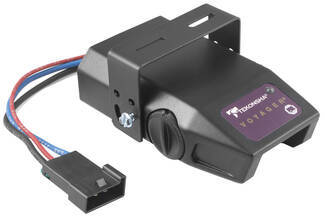
You can fine-tune the gain by adjusting the sensitivity of the internal sensor using the knob on the left side. This controls the aggressiveness of your trailer's braking, meaning how quickly the brakes reach the maximum braking level. You can adjust this when you're towing heavy loads and you need more umph to bring your trailer to a stop. Your tow vehicle doesn't need that much power to brake in time, but your heavy trailer does. A high sensitivity level will get the braking power to your trailer brakes faster and with more intensity so that it doesn't push your tow vehicle forward.
LED Indicator
Keeping with its simple design, the Voyager will not overwhelm you with information. An LED indicator on the top of the unit lights up green to show that your trailer is securely connected to your tow vehicle. The LED indicator will change to red when the brakes on your trailer are activated.
During installation and setup, this light is also used to ensure that the Voyager will be able to function correctly. Proper leveling of the internal sensor is crucial to the operation of this brake controller. When the sensor is level, the LED will change to a shade of orange.
Simple Installation
The Voyager is designed to be mounted in your cab at a vertical angle that is between -20 degrees and 70 degrees. The brake controller needs to be horizontally level and parallel to the direction of travel in order to function properly.


To connect the Voyager, just plug the included harness into your vehicle. The other end plugs into the controller - no hardwiring required.
Once the controller is mounted and connected, you must level the internal sensor. First, set the overall power to the maximum using the knob on the side of the controller. Then, while pressing the tow vehicle's brake pedal, adjust the level knob on the other side of the brake controller (this is the same knob that is used to fine-tune the power output) until the LED monitor is a shade of orange.
Note: If you don't already have a 7-way plug at the back of your vehicle, take a look at our exclusive 7- and 4-way brake controller installation kit (ETBC7 - sold separately).
Proportional Braking
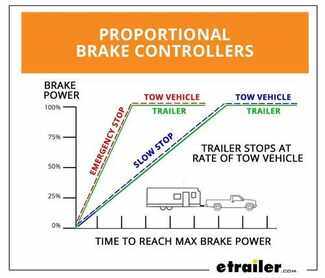
The Tekonsha Voyager brake controller comes equipped with proportional braking to give you the best towing experience. Proportional braking means that your trailer brakes mimic your tow vehicle's brakes. If you slam on the brakes in your vehicle, your trailer brakes will activate with the same intensity; if you brake lightly, your trailer brakes lightly too. The trailer's braking is in proportion to your vehicle's braking. This saves wear and tear on the tires and the brakes on both your vehicle and trailer.
The Voyager uses a pendulum system to sense how your vehicle is braking so it can send the right amount of braking power to your trailer. It measures the inertia of your tow vehicle and activates the trailer's brakes to slow at the same rate. The result is uniform braking across your towing setup. No push-pull action - just smooth, proportional braking every time.
9030 Tekonsha Voyager Electric Brake Controller - 1 to 4 Axles - Proportional
302100 Tekonsha Brake Control Wiring Adapter with 2 Plugs
Replaces Tekonsha 3021-P
Installation DetailsCalifornia residents: click here

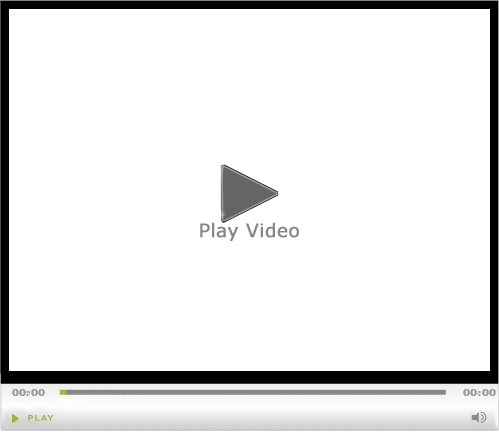
Videos are provided as a guide only. Refer to manufacturer installation instructions and specs for complete information.
Video Transcript for Install: Tekonsha Voyager Trailer Brake Controller on a 2006 Dodge Ram Pickup
Today in our 2006 Dodge Ram pickup, we'll be installing the Tekonsha Voyager Brake Controller for 1 to 4 axles, part number 39510. We'll use this in conjunction with our Tekonsha Plug and Play direct fit wiring harness, part number 3020-P. Now to begin our install, we'll first go ahead and locate the manufacturer's brake controller port. The brake controller port is located behind the parking brake pedal, above the manufacturer's main wiring harness. This is a blue connector and is secured here to the ECM. Now we've located it. We'll go ahead and pop it free so that we can plug the direct fit wiring harness directly into it. To plug the harness into it, we'll take the white connector of our direct fit harness and plug in to the blue port. Once we have it plugged in, we'll go ahead and leave our wires hang, or if you can get your connector back in place, you can go ahead and do that now. Next, we'll move over to mounting the brake controller.
To mount our brake controller, we'll take our brake controller bracket and the hardware provided, and secure it here to the bottom of the dash. Once we have our brake controller bracket in position, we can then go ahead and secure our brake controller to the bracket. Quick tech tip, to assist in getting the brake controller mounted to the bracket, we're going to go ahead and pre-drill the 4 attachment points here on our brake controller. We have 2 on 1 side and 2 on the other. Using 1 of the fasteners included with the install kit, we can pre-drill the holes. Once we have them pre-drilled, we'll then go ahead and put our brake controller in place, and install the 4 fasteners finger tight.
Now with all 4 fasteners in place, we'll go ahead and tighten them down. Now with the brake controller mounted and secured, we're ready to go ahead and route our wiring harness. Keep in mind, when routing your harness to stay away from any moving components, such as the gas or brake pedal, or the steering wheel column. As we route the wiring, we're also going to use some zip ties to secure, as necessary. Once I have the wiring routed, over to the brake controller, we can take the pigtail from the brake controller and plug it into the wiring harness. Once I have it plugged in, I'll then go ahead and finish securing the wiring up under the dash. Now once we have the wiring secured, we'll go ahead and cut off the excess from the zip ties to clean up our install look. Once our brake controller is completely installed, we need to set the level sensor. Here on the driver's side of the brake controller is our hand knob.
We'll rotate it so that it's straight up and down, setting the level position's sensor of our brake controller. Now with our level sensor set, to go ahead and test our brake controller, we'll go ahead and plug in our trailer, so that we can provide a load on the brake controller. Now, you'll see that with our trailer plugged in, we have a green light, indicating that we have a connection with our trailer braking. Next, here on the passenger side of the brake controller, is our gain control. This will allow us to increase or decrease power going to our trailer braking for light or heavy loads. Another feature of the Voyager Brake Controller is the hand or manual braking. By applying the manual brake, as you can see, it increases the power going to our trailer braking, orange for middle power, and red for full power.
This will allow you to activate the trailer brakes without pressing the brake pedal of the vehicle. And there you have it for the install, setup and operation of the Tekonsha Voyager Brake Controller, part number 39510, in conjunction with the Tekonsha Plug and Play Wiring Harness, part number 3020-P, for our 2006 Dodge Ram pickup. .
Ratings & Reviews
4.8
750 reviews
See what our Experts say about this Tekonsha Trailer Brake Controller
- Most Economical Trailer Hitch Receiver and Wiring Harness For a 2023 Honda Pilot TouringOur etrailer Trailer Hitch Receiver # e27KR you found is our most economical custom fit receiver for your 2023 Honda Pilot Touring edition. For the wiring you can select from either the 4-Way # C48ZV or the 7-Way # C35ZV depending on the types of trailers you will be towing. If you have a trailer with a 7-way you are also most likely going to need a Trailer Brake Controller # 39510 along with the Wiring # 20127 to connect it. This is one of our most economical and reliable proportional...
view full answer... - Should Blue Wire From Brake Controller Have Constant PowerThe blue wire coming from the back of your Tekonsha Voyager Brake Controller # 39510 is for brake output to the 7-Way connector. This wire should only have power with the brake pedal depressed or the manual override activated on the brake controller. If you are getting constant power on this blue wire this may be an indication that the controller is bad but there is an easy way to test this. You will want to first sever the blue wire several inches from the back of the controller. Then...
view full answer... - Is Reese Voyager and Tekonsha Voyager the Same Brake ControllerThey are the same controller as Reese and Tekonsha are made by the same company. The Tekonsha part # 39510 does not come with the vehicle specific install harness part # 3035-P which is custom fit for your 2003 Ford F-250/350.
view full answer... - Tekonsha Voyager Brake Controller Not Activating Trailer Brakes When Brake Pedal Is PressedYes, we can help you test your brake controller and determine if the controller is bad or if there is a wiring issue that is causing the problem on your 2003 Ford F-250 pickup. Lets start with the easiest things first. Be sure that when you are testing the trailer brakes with the brake pedal that the vehicle is moving. The trailer brakes will not apply with the brake pedal if the vehicle is not moving because of the proportional sensor. The first thing I would check is the red wire that...
view full answer... - Troubleshooting No Green Light on Tekonsha Voyager Brake ControllerThe green light on top of your Tekonsha Voyager Trailer Brake Controller # 39510 indicates that a trailer is connected to your vehicle. If this light is not turning on when connected to a trailer there are a couple things, you can check. I first recommend inspecting both the vehicle side and trailer side connectors for any debris or corrosion built-up around the pins that needs to be cleaned out. If the connectors look good, you will next want to test the brake output pin on the vehicle...
view full answer... - Trailer Brakes Do Not Activate With Brake Pedal When Trailer is Sitting StillActually that is a possibility. Proportional brake controllers will not engage the brakes with the pedal unless the tow vehicle is in motion. Another possibility is the red wire from the brake controller isn't connected correctly. It needs to be connected to the cold side of the stop light switch or the wire that is hot only when the brake pedal is pressed. I would also check any fuses related to towing and replace if necessary. If none of these ideas solves your problem let me know...
view full answer... - Which Harness to Install Tekonsha Voyager in 2019 Ram 1500 ClassicWhat brand and model is the brake controller? The Rams changed quite a bit in 2015 so a new harness would be needed. But if you can get me the controller you have I can help pick you out what you'd need.
view full answer... - Fuse Location to Power an Electric Trailer Brake Controller on a 2005 Chevy SilveradoThe Tekonsha Voyager Brake Controller with GM Wiring Harness, # 39510 and # 3015-P, itself does not have a fuse. Since it is connected to the truck via the factory port under the dash, the fuse for the brake controller 12 volt power is located in the power distribution box under the hood. We actually have an FAQ article that explains the installation of a brake controller Chevy and GMC trucks that includes your 2005 Silverado. It covers the connections that need to be made under the hood...
view full answer... - Voyager Brake Controller Red Light Not Coming On with Brakes Applied on a 2004 Chevy SilveradoThere are several possible causes that would lead the red light not to come on when applying the brakes or manual override on the Tekonsha Voyager Brake Controller, # 39510. First, if truck is not moving, the brakes will not activate. You will also want to check to make sure the power setting is not too low. There may be no signal from the brake light switch. You will need to test the red wire from the back of the brake controller using a circuit tester like # PTW2993. If there is no voltage,...
view full answer... - Recommended Wiring for 1998 Ford F-150 to Add 7-Way to Factory 4-Way Trailer ConnectionFor your 1998 Ford F-150 Extended Cab with factory 4-way flat, you need the Tekonsha Ford Replacement OEM Tow Package Wiring Harness, 7-Way # 118242. This will give you the two additional relays needed as well as the wiring harness. Then you will need a brake controller. I recommend the Tekonsha Prodigy P3 # 90195 as well as the wiring adapter # 3035-P. This will give you an easy to use proportional brake controller with easy to use presets as well as a nice LCD screen for diagnostics....
view full answer... - Troubleshooting a Tekonsha Voyager Brake ControllerHey Scott! You're going to need to connect a trailer to your vehicle. You're not going to know what's working correctly or incorrectly on the Tekonsha Voyager item # TK29ER unless you hook a trailer up. If you run into any problems down the road feel free to comment below or email me directly and I'll be happy to walk through them with you.
view full answer... - What Are the Brake Controller Wire Colors for on a 1998 Dodge Ram 2500The factory electric trailer brake controller wires on a 1998 Dodge Ram 2500 are as follows: Power - Red/Orange Ground - Black/Orange Stop Light - White/Tan Brake Output - Light Blue For a brake controller, I recommend using the Tekonsha Voyager Trailer Brake Controller part # 39510. It sounds like the previous owner of your truck may have cut off the old brake controller port so you are also going to want to use the Replacement Brake Control Plug-In Harness for Tekonsha and Draw-Tite...
view full answer... - Troubleshooting Vehicle that Won't Start After Brake Controller InstallWithout knowing what truck you have it's hard for me to know if you have the correct harness. I will say that the problems you are describing are unlike any problems we have ever seen from installing a brake controller. If removing the brake controller makes the problems go away then I would strongly recommend you do so until you figure out why this problem is occurring. Make sure you have your truck shifted into park or neutral before you attempt to start it. You may have moved the shifter...
view full answer... - Where is the Brake Controller Plug In Located on a 2011 Ford F-250 Super DutyOn the 2011 Ford F-250 Super Duty, the brake controller port is located behind the center dashboard access panel on the passenger's side. One end of the # 3034-P adapter will plug into the back of the brake controller and the other end plugs into the brake controller port on your vehicle. If your vehicle has the factory 7-Way connector on the rear of your vehicle, then all of the wires for the brake controller have already been run. If you have a factory 4-Way connector on your vehicle...
view full answer... - Troubleshooting Voyager Trailer Brake Controller Not Working when Brake Pedal is PressedIt is possible that either the connection to the brake switch is no longer good enough to provide an adequate signal to the brake controller and a new connection will need to be made, or there is a short or possibly a bad ground causing the problem. You may want to also check the stoplight fuse. A blown fuse will not allow the signal to get through and the brake controller will not know you are stepping on the brakes. You can find the fuse by checking your owners manual which should have...
view full answer... - Troubleshooting LED Indicator Light on Tekonsha Voyager Brake Controller 39510The green light on the Voyager brake controller # 39510 should come on as soon as you plug the trailer into the vehicle. If it does not come on at all, this indicates that you either have some corrosion inside the trailer or vehicle plugs that is causing a short, or you have a loose power or ground connection. Check the plugs on both sides of the setup for any white or green corrosion. If you see any, clean the plug thoroughly or just replace it. If you don't see any buildup in either...
view full answer... - How to Find the Brake Wire on a 2001 Toyota Tacoma for Brake Controller InstallWhen we installed a brake controller in a very similar Toyota Tacoma as your (see attached install video), we found that the correct wire to use for the stoplight switch was dark green wire with a white stripe. You should still test this wire for voltage with the circuit tester to verify it is the correct one. But this would be an excellent starting point.
view full answer... - Recommended Brake Controller for a 2018 Thor Ace MotorhomeFor your 2018 Thor Ace Motorhome, I recommend using the Curt Spectrum Trailer Brake Controller part # C51170. The reason for this is because this unit is composed of two main parts, the control box and the output knob. The control box gets mounted out of site and then the output knob will get installed up on your dash for easy use and a very aesthetically pleasing look. The color output of the knob also helps with ease of use. Since your motorhome is on a Ford F-53 chassis, you can use...
view full answer... - Casita Travel Trailer With Repeated Issues On Left Side Of Axle OnlyHello Paul. It sounds like you have an axle, or axle mounts that are out of alignment. That is really the only explanation since the issue has been reoccurring even after several replacements. I wonder if the 1st axle sustained damage of some sort which bent the mounts. This would explain the bearings overheating also. At this point I suggest you take your camper to a shop and have them check the alignment of the axles and the mounts.
view full answer... - Troubleshooting A Tekonsha Voyager Brake Controller That Isn't Sensing The TrailerHi Howard, Typically if the Tekonsha Voyager Trailer Brake Controller # 39510 isn't detecting the trailer it's just an issue with the trailer connectors not making a solid connection. Check the pins on your trailer connector to see if they're corroded, damaged, bent, or dirty. A lot of the time the pins get bent back from connecting to the 7-way socket on the vehicle over and over and just need to be bent back into place with a thin flathead screwdriver so that they contact the pins in...
view full answer... - What To Do if an RV Dealership Installs a Brake Controller Incorrectly and Damages Cruise ControlIt sounds like the RV dealership that installed your Tekonsha Voyager Brake Controller part # 39510 did not install the controller correctly initially, and even though he attempted to rewire the controller the damage was done to your vehicle and now you have lost cruise control. I would recommend having the mechanic look at the circuits like you are doing, and then once they confirm that the initial install of the controller screwed up your cruise control circuit I would go back to the...
view full answer... - Correct Brake Controller Adapter for 2011 Ford F-150If you have one of the following brake controllers, we offer a complete plug-in application. No wiring needed, just plug one end of the Tow Ready Plug-In Wiring Adapter, # 22292, into your brake controller and the other end will plug into the built-in harness beneath the dash on your 2011 Ford F-150. Brake EVN # TK63VR Tekonsha PowerTrac # 39523 Tekonsha P2 # 90885 Tekonsha P3 # 90195 Tekonsha Primus IQ # TK90160 Tekonsha Voyager # 39510 If you have a different brand of brake controller,...
view full answer... - What Hitch do You Recommend for My 2022 Subaru Forester?Definitely! The main factors that determine the hitch are hitch receiver opening size (either 1-1/4" or 2"), weight capacity offered, and how the hitch installs on your vehicle. For example, if you are looking for a hitch that is compatible with most accessories and provides you with the most weight capacity, I recommend going with a 2" hitch like the Curt Hitch - 2" # C13409. Not only does this hitch provide you with the most weight capacity we offer for your vehicle (525 maximum tongue...
view full answer... - Trailer Brake Controller No Longer Works with Brake Pedal on a 2008 Chevy SilveradoThis sounds like a problem on the red wire. The red wire is the input wire from the brake switch that tells the controller when you are stepping on the brake pedal. Use a circuit tester like # PTW2993 if needed to test the wire. If there is no signal when you step on the pedal, then you know this is the culprit. There are a couple of things you can check but since it was working before the most likely problem is a blown stop light or CHMSL fuse. Use the vehicle owner's manual to find...
view full answer... - Troubleshooting Trailer Brake Assemblies that Are New But Not StrongSince you mentioned that your brakes are brand new it's very likely you have a set of self-adjusting brake assemblies that just haven't adjusted fully to the point of activating strongly. This is a very common problem actually and has a very easy solution. What you'll want to do is find somewhere you can tow your trailer slowly like an empty parking lot and the manual override lever of the brake controller several times. Each time you apply the override the assemblies will tighten slightly...
view full answer... - How to Install Aftermarket Brake Controller in 2011 Ram 3500 w Integrated Factory Brake ControllerYes, there is a way to install an aftermarket brake controller on your 2011 Ram 3500 that has an integrated controller in it already. To install an aftermarket brake control you will have to disconnect the ITBM. This will turn on a warning lamp on the instrument cluster. In order to disconnect the ITBM and not get the warning lamp, your local Dodge dealer will have to reconfigure the TIPM (Totally Integrated Power Module), of the truck. Once the TIPM has been reconfigured, and the ITBM...
view full answer... - How to Bypass Integrated Brake Controller of 2010 Dodge Ram 3500 to Install Prodigy P3Bypassing the factory brake controller of your 2010 Dodge Ram with the Prodigy P3 part # 90195 only requires you to install it with the install harness part # 3021-P. The vehicle will also need the computer flashed so it will keep from searching for the connection to the OEM brake controller in the future, eliminating any fault codes. This will usually have to be done at the Dodge Dealer. The truck will recognize the P3 once this is done. I attached an install video for this for you...
view full answer... - Can the Integrated Brake Controller of a 2011 Dodge Ram 3500 Activate a Carlisle EOH Brake ActuatorThe factory brake controller in your 2011 Dodge Ram 3500 is not compatible with the HydraStar Electric-Hydraulic Actuator for Disc Brakes # HBA16 that you referenced. There is no adapter available that would make it work either. Your only option would be to replace your factory controller with an aftermarket one that is confirmed to work with electric over hydraulic brakes. The one we recommend the most is the Prodigy P2 Brake Controller part # 90885. I attached a link to an FAQ article...
view full answer... - Install Brake Controller Harness Recommendation for 2011 Dodge Ram 1500For installing a brake controller in your 2011 Dodge Ram 1500 the correct install harness is the part # 3021-P which we have confirmed as a fit. This would be the adapter you'd need that would plug into the connector you found. If you check out the install video I attached below you can see where you will find the install harness on your truck. For a brake controller I would recommend the Prodigy P2 Brake Controller part # 90885. This is our best selling brake controller because of how...
view full answer... - Can Brake Controllers be Installed in a Vehicle without an Install Harness 3023-PBrake controllers can be hardwired to vehicles as they do not have to install with an install adapter like the part # 3023-P. Actually most vehicles do not have a quick install harness available so the hardwire option is a very common route. If the brake controller is not working and is a vehicle that calls for the # 3023-P being installed on it the problem is most likely due to the fact that it is an older model brake controller that is not compatible with your truck, and because due...
view full answer... - Can Brake Controller of 2011 Dodge Ram Be Replaced to be Used with Hydraulic BrakesThe factory controller of your 2011 Dodge Ram would need to be replaced with one that is compatible with electric over hydraulic brakes like the Prodigy P3 # 90195 that you referenced. There isn't a way to convert what you have by a setting change. In order to disconnect the ITBM and not get the warning lamp, your local Dodge dealer will have to reconfigure the TIPM (Totally Integrated Power Module), of the truck. Once the TIPM has been reconfigured, and the ITBM has been unplugged, you...
view full answer... - Is There A Custom Harness To Plug A Tekonsha P3 Into A 2012 Ram 3500?We most certainly do, Clifton! The Tekonsha Plug-In Wiring Adapter for Electric Brake Controllers - Dodge # 3021-P will plug directly into the back of your Tekonsha P3 # 90195 and then into a port up under your dash, kind of between the brake pedal and the emergency/parking brake pedal (see picture). Then just mount the controller and you are on your way! Out of curiosity, did your P3 come out of another vehicle you have?
view full answer... - Factory Brake Controller on 2012 Ram 3500 Will Not Work With EOH BrakesIt sounds like your factory brake controller on your 2012 Ram 3500 is at the end of it's life, or that it isn't compatible with an EOH brake configuration even though it is supposed to be. One other thing you can do to double check, is to set the brake controller at 0.0 and have a buddy depress the brake pedal while you use a Circuit Tester, like part # 40376, to see what the voltage is for the brake controller on the 7-Way at the rear of your Ram. You will want to test the pin in the...
view full answer... - Replacing Factory Brake Controller On Dodge Ram Truck I called my contact at Tekonsha and asked about replacing the Dodge Integrated Brake Controller if the truck is a 2010 through 2015. If you have a different year Ram just let me know and I can make some recommendations that will work for you. They told me the best way to go about replacing the controller is to take the vehicle to a Dodge dealership and have them disconnect the ITBM. Doing this will turn on a warning lamp on the instrument cluster. The dealership will then need to reconfigure...
view full answer... - Replacing Wiring on Old Livestock Trailer with Electric BrakesTo replace the wiring in your old livestock trailer and install a 7-Way connector to use with your tow vehicles, I recommend using a 7-Way harness like the Hopkins 7-Way Molded Trailer Wire Connector # H20046. When installing the connector and harness on the trailer, you will want to use a junction box # 38656 and 10 gauge wire # 10-1-1 (sold by the foot), which will help protect the connection points and also give the installation a more professional look. The 10 gauge wire will be needed...
view full answer... - Installing an Aftermarket Brake Controller on a 2012 Ram with Factory Brake ControllerIn order to install an aftermarket brake controller like the Tekonsha Prodigy P2 Trailer Brake Controller part # 90885 on a 2012 Ram 1500/2500/3500 with an integrated trailer brake module (ITBM) you will need to take the truck to your local Dodge dealer and have them reconfigure the power control module. This is all outlined in the attached help article. If your 2012 Ram 1500/2500/3500 has a factory 7-way trailer connector then you will want to use part # 3021-P to install the above...
view full answer... - Brake Controller Recommendation to Bypass Integrated Brake Controller of 2011 Ram 2500You can bypass the factory brake controller on a 2011 Dodge Ram but there are a few things to do first. I have explained it below and also included a link to an FAQ that will help. To install an aftermarket brake controller on a 2011 Dodge Ram that has the factory integrated controller you will have to disconnect the ITBM (Integrated Trailer Brake Module). Doing so will turn on a warning lamp on the instrument cluster. In order to disconnect the ITBM and not get the warning lamp, your...
view full answer... - Dodge Factory Brake Controller Does Not Work with Electric Over Hydraulic Brakes on Horse TrailerIt sounds as if you have an electric over hydraulic braking system on your horse trailer. Most OEM brake controllers are not compatible with electric over hydraulic actuators. If you trailer brakes are working, you may find that your actuator is cycling on and off when connected to the truck and this will significantly shorten the life of the actuator. The Dodge factory brake controllers are designed to be used with electric trailer brakes only and are not designed to be used with electric...
view full answer... - Comparing Tekonsha P2 # 90885 and P3 # 90195 Trailer Brake ControllersYou win on this one either way! Both the Tekonsha Prodigy P2 # 90885 and P3 # 90195 versions are superb proportional brake controllers that are among the highest-rated of all such items we sell. Both offer compatibility with either electric or electric-over-hydraulic brakes, both allow a 360-degree vertical plane operating range and both provide proportional braking to minimize wear and tear on your vehicle and trailer brakes. The main difference between them is the display, which for...
view full answer... - What are the Wire Functions on the Factory Brake Controller Plug in a 2012 Ram 1500So, by looking at your picture and comparing it to harness # 3021-P for a 2012 Ram 1500 it looks like the pink /white wire is ground, green/black is 12-volt power in, yellow/red is output to the trailer brakes, and green is input from the brake switch. You can test this using a circuit tester such as # PTW2993. A wire that has 12-volt power all the time goes to the brake controller black wire. A wire that only has power when the brake pedal is pressed goes to the brake controller red wire. You...
view full answer... - How Does Ram Factory Brake Controller Install in 2012 Ram 1500On your 2012 Ram 1500 that has a factory 4/7-way, there will be a port under the dash for connecting a trailer brake controller like the (presumably used) OEM unit you bought. There are lots of these units out there as many owner's end up replacing the OEM units with better-performing aftermarket controllers like the Prodigy P3 # 90195. The controller does not require any programming to operate. The vehicle computer may need to be flashed by the dealer if you find you get error messages...
view full answer... - Location of Brake Controller Port on 2010 Dodge Ram For Tekonsha Brake Control Adapter, # 3021-P,The brake controller harness is located under the dash on the drivers side, just left of the steering column, and near the emergency brake pedal. See picture at the right. I am sending a link on the installation instructions on a 2010 Dodge Ram. It shows the location of the factory port, for the plug in of the Tekonsha Brake Control Adapter - 2010 Dodge, # 3021-P, on your 2010 Dodge Ram 1500.
view full answer... - 2012 Dodge Ram Brake Controller Plug LocationThe harness is located underneath the dash, to the left of the steering column, taped to another harness near the emergency brake pedal. I attached a picture that shows what it looks like. I also attached installation instructions for the Tekonsha Harness # 3021-P. This is the harness that is designed for the brake controller port to install a brake controller to a Tekonsha brake controller like a P2 brake controller part # 90885.
view full answer... - Installing Brake Controller on 2008 Dodge Ram 1500 4x4Thank you for sending the photo, it really makes things easier! The connector you show in your photo is not the connector for installing a brake controller. If you look on the firewall behind the emergency brake, you will see a white wiring junction box. The blue female connector that accepts the # 3020-P brake control wiring adapter is located alongside or on top of this junction box, as you can see in the photo I have edited for you. I have also linked you to an install video that shows...
view full answer... - Installation of Tekonsha P3 Brake Controller on a 2011 Dodge Ram PickupIt sounds like your Ram pickup is in the 4th generation which is from 2010 to present so I would think that the 2013 video would be closer related than the 2008, which is part of the 3rd generation. I also linked a snapshot from the directions of the adapter plug # 3021-P which shows where the corresponding plug on your vehicle will be. I wish we had more vehicle installs but are limited by what customers vehicles come into our shop. Where to mount the Tekonsha P3 # 90195 is generally...
view full answer... - How to Bypass Factory Integrated Brake Controller on a 2011 Ram 3500You can bypass the factory brake controller on a 2011 Dodge Ram but there are a few things to do first. I have explained it below and also included a link to an FAQ that will help. To install an aftermarket brake controller on a 2011 Dodge Ram that has the factory integrated controller you will have to disconnect the ITBM (Integrated Trailer Brake Module). Doing so will turn on a warning lamp on the instrument cluster. In order to disconnect the ITBM and not get the warning lamp, your...
view full answer... - How to Bypass Factory Integrated Brake Controller on a 2012 Ram You can bypass the factory brake controller on a 2012 Dodge Ram but there are a few things to do first. I have explained it below and also included a link to an FAQ that will help. To install an aftermarket brake controller on a 2012 Dodge Ram that has the factory integrated controller you will have to disconnect the ITBM (Integrated Trailer Brake Module). Doing so will turn on a warning lamp on the instrument cluster. In order to disconnect the ITBM and not get the warning lamp, your...
view full answer... - Factory Brake Controller Connector Location for a 2007 Dodge RamThe connector on the 2007 Dodge Ram is blue but is not like the one you have found. Instead, take a look at the picture I added that shows its location and what it looks like. Also take a look at the video I have linked which will help to locate and identify the correct connector. The one you are looking for will have 4 pins. If your truck did not come with a factory 7-Way trailer connector then the truck will not have the connector for a brake controller. A brake controller will need...
view full answer...
Do you have a question about this Trailer Brake Controller?
Info for this part was:





At etrailer.com we provide the best information available about the products we sell. We take the quality of our information seriously so that you can get the right part the first time. Let us know if anything is missing or if you have any questions.

































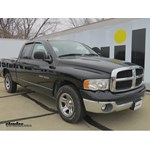
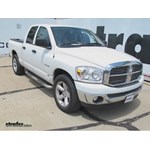
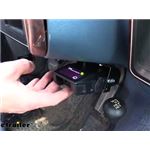
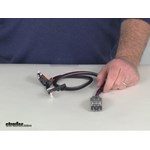
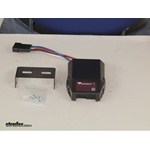




























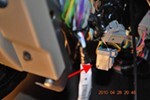
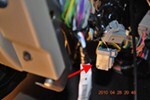




Thank you! Your comment has been submitted successfully. You should be able to view your question/comment here within a few days.
Error submitting comment. Please try again momentarily.